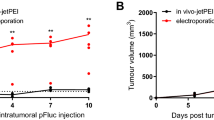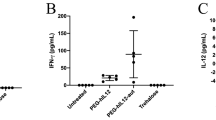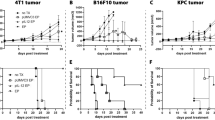Abstract
Depsipeptide, a histone deacetylase (HDAC) inhibitor, kills tumor cells much more effectively than normal cells, and can produce significant antitumor activity in human cancer patients. Depsipeptide also increases the expression of lipoplex-delivered genes in cultured tumor cells, as well as following direct intra-tumoral injection. We now show that co-intravenous (i.v.) injection of depsipeptide with polyethylenimine (PEI):DNA complexes significantly increases the expression of PEI-delivered genes in normal, as well as in tumor-bearing mice. At the tissue level, depsipeptide-mediated enhancement of gene expression was selectively targeted to the lung, liver and spleen. At the cellular level, depsipeptide significantly increased the expression of the i.v., PEI co-delivered wild-type human p53 gene in metastatic breast cancer cells, but not in adjacent normal cells. Thus, the ability of depsipeptide to enhance the expression of systemically delivered genes is selectively targeted at both the tissue and cellular levels, without requiring the use of ligand- or promoter-based approaches. Analyzing HDAC-based targeting of gene expression may identify host genes that control the expression of systemically delivered genes.
This is a preview of subscription content, access via your institution
Access options
Subscribe to this journal
Receive 12 print issues and online access
$259.00 per year
only $21.58 per issue
Buy this article
- Purchase on Springer Link
- Instant access to full article PDF
Prices may be subject to local taxes which are calculated during checkout





Similar content being viewed by others
References
Ueda H, Nakajima H, Hori Y, Goto T, Okuhara M . Action of FR901228, a novel antitumor bicyclic depsipeptide produced by Chromobacterium violaceum no. 968, on Ha-ras transformed NIH3T3 cells. Biosci Biotechnol Biochem 1994; 58: 1579–1583.
Furumai R, Matsuyama A, Kobashi N, Lee KH, Nishiyama M, Nakajima H et al. FK228 (depsipeptide) as a natural prodrug that inhibits class I histone deacetylases. Cancer Res 2002; 62: 4916–4921.
Byrd JC, Shinn C, Ravi R, Willis CR, Waselenko JK, Flinn IW et al. Depsipeptide (FR901228): a novel therapeutic agent with selective, in vitro activity against human B-cell chronic lymphocytic leukemia cells. Blood 1999; 94: 1401–1408.
Nakajima H, Kim YB, Terano H, Yoshida M, Horinouchi S . FR901228, a potent antitumor antibiotic, is a novel histone deacetylase inhibitor. Exp Cell Res 1998; 241: 126–133.
Yoshida M, Horinouchi S, Beppu T . Trichostatin A and trapoxin: novel chemical probes for the role of histone acetylation in chromatin structure and function. Bioessays 1995; 17: 423–430.
Wolffe AP, Pruss D . Targeting chromatin disruption: transcription regulators that acetylate histones. Cell 1996; 84: 817–819.
Grunstein M . Histone acetylation in chromatin structure and transcription. Nature 1997; 389: 349–352.
Condreay JP, Witherspoon SM, Clay WC, Kost TA . Transient and stable gene expression in mammalian cells transduced with a recombinant baculovirus vector. Proc Natl Acad Sci USA 1999; 96: 127–132.
Yamano T, Ura K, Morishita R, Nakajima H, Monden M, Kaneda Y . Amplification of transgene expression in vitro and in vivo using a novel inhibitor of histone deacetylase. Mol Ther 2000; 1: 574–580.
Goldsmith ME, Kitazono M, Fok P, Aikou T, Bates S, Fojo T . The histone deacetylase inhibitor FK228 preferentially enhances adenovirus transgene expression in malignant cells. Clin Cancer Res 2003; 9: 5394–5401.
Handumrongkul C, Zhong W, Debs RJ . Distinct sets of cellular genes control the expression of transfected, nuclear-localized genes. Mol Ther 2002; 5: 186–194.
Goula D, Benoist C, Mantero S, Merlo G, Levi G, Demeneix BA . Polyethylenimine-based intravenous delivery of transgenes to mouse lung. Gene Therapy 1998; 5: 1291–1295.
Zou SM, Erbacher P, Remy JS, Behr JP . Systemic linear polyethylenimine (L-PEI)-mediated gene delivery in the mouse. J Gene Med 2000; 2: 128–134.
Sasakawa Y, Naoe Y, Sogo N, Inoue T, Sasakawa T, Matsuo M et al. Marker genes to predict sensitivity to FK228, a histone deacetylase inhibitor. Biochem Pharmacol 2005; 69: 603–616.
Sasakawa Y, Naoe Y, Noto T, Inoue T, Sasakawa T, Matsuo M et al. Antitumor efficacy of FK228, a novel histone deacetylase inhibitor, depends on the effect on expression of angiogenesis factors. Biochem Pharmacol 2003; 66: 897–906.
Liu Y, Mounkes LC, Liggitt HD, Brown CS, Solodin I, Heath TD et al. Factors influencing the efficiency of cationic liposome-mediated intravenous gene delivery. Nat Biotechnol 1997; 15: 167–173.
Coll JL, Chollet P, Brambilla E, Desplanques D, Behr JP, Favrot M . In vivo delivery to tumors of DNA complexed with linear polyethylenimine. Hum Gene Ther 1999; 10: 1659–1666.
Felgner PL, Gadek TR, Holm M, Roman R, Chan HW, Wenz M et al. Lipofection: a highly efficient, lipid-mediated DNA-transfection procedure. Proc Natl Acad Sci USA 1987; 84: 7413–7417.
Liu Y, Liggitt D, Zhong W, Tu G, Gaensler K, Debs R . Cationic liposome-mediated intravenous gene delivery. J Biol Chem 1995; 270: 24864–24870.
Liu Y, Liggitt HD, Dow S, Handumrongkul C, Heath TD, Debs RJ . Strain-based genetic differences regulate the efficiency of systemic gene delivery as well as expression. J Biol Chem 2002; 277: 4966–4972.
Liu Y, Thor A, Shtivelman E, Cao Y, Tu G, Heath TD et al. Systemic gene delivery expands the repertoire of effective antiangiogenic agents. J Biol Chem 1999; 274: 13338–13344.
Wang H, Mohammad RM, Werdell J, Shekhar PV . p53 and protein kinase C independent induction of growth arrest and apoptosis by bryostatin 1 in a highly metastatic mammary epithelial cell line: In vitro versus in vivo activity. Int J Mol Med 1998; 1: 915–923.
Chavez-Blanco A, Segura-Pacheco B, Perez-Cardenas E, Taja-Chayeb L, Cetina L, Candelaria M et al. Histone acetylation and histone deacetylase activity of magnesium valproate in tumor and peripheral blood of patients with cervical cancer. A phase I study. Mol Cancer 2005; 4: 22.
Yamamoto S, Yamano T, Tanaka M, Hoon DS, Takao S, Morishita R et al. A novel combination of suicide gene therapy and histone deacetylase inhibitor for treatment of malignant melanoma. Cancer Gene Ther 2003; 10: 179–186.
Byrd JC, Marcucci G, Parthun MR, Xiao JJ, Klisovic RB, Moran M et al. A phase 1 and pharmacodynamic study of depsipeptide (FK228) in chronic lymphocytic leukemia and acute myeloid leukemia. Blood 2005; 105: 959–967.
Sandor V, Bakke S, Robey RW, Kang MH, Blagosklonny MV, Bender J et al. Phase I trial of the histone deacetylase inhibitor, depsipeptide (FR901228, NSC 630176), in patients with refractory neoplasms. Clin Cancer Res 2002; 8: 718–728.
Liu F, Qi H, Huang L, Liu D . Factors controlling the efficiency of cationic lipid-mediated transfection in vivo via intravenous administration. Gene Therapy 1997; 4: 517–523.
Schena M, Shalon D, Heller R, Chai A, Brown PO, Davis RW . Parallel human genome analysis: microarray-based expression monitoring of 1000 genes. Proc Natl Acad Sci USA 1996; 93: 10614–10619.
Van Lint C, Emiliani S, Verdin E . The expression of a small fraction of cellular genes is changed in response to histone hyperacetylation. Gene Expr 1996; 5: 245–253.
Peart MJ, Smyth GK, van Laar RK, Bowtell DD, Richon VM, Marks PA et al. Identification and functional significance of genes regulated by structurally different histone deacetylase inhibitors. Proc Natl Acad Sci USA 2005; 102: 3697–3702.
Zhang J, Attar E, Cohen K, Crumpacker C, Scadden D . Silencing p21(Waf1/Cip1/Sdi1) expression increases gene transduction efficiency in primitive human hematopoietic cells. Gene Therapy 2005; 12: 1444–1452.
Brunner S, Sauer T, Carotta S, Cotten M, Saltik M, Wagner E . Cell cycle dependence of gene transfer by lipoplex, polyplex and recombinant adenovirus. Gene Therapy 2000; 7: 401–407.
Prasmickaite L, Hogset A, Berg K . The role of the cell cycle on the efficiency of photochemical gene transfection. Biochim Biophys Acta 2002; 1570: 210–218.
Templeton NS, Lasic DD, Frederik PM, Strey HH, Roberts DD, Pavlakis GN . Improved DNA:liposome complexes for increased systemic delivery and gene expression. Nat Biotechnol 1997; 15: 647–652.
Kircheis R, Blessing T, Brunner S, Wightman L, Wagner E . Tumor targeting with surface-shielded ligand–polycation DNA complexes. J Control Rel 2001; 72: 165–170.
Shi N, Zhang Y, Zhu C, Boado RJ, Pardridge WM . Brain-specific expression of an exogenous gene after i.v. administration. Proc Natl Acad Sci USA 2001; 98: 12754–12759.
Fong S, Liu Y, Heath T, Fong P, Liggitt D, Debs RJ . Membrane-permeant, DNA-binding agents alter intracellular trafficking and increase the transfection efficiency of complexed plasmid DNA. Mol Ther 2004; 10: 706–718.
Fong S, Itahana Y, Sumida T, Singh J, Coppe JP, Liu Y et al. Id-1 as a molecular target in therapy for breast cancer cell invasion and metastasis. Proc Natl Acad Sci USA 2003; 100: 13543–13548.
Acknowledgements
This work was supported by Grants CA96666 and CA109174 from the NIH-NCI to RJD.
Author information
Authors and Affiliations
Corresponding author
Rights and permissions
About this article
Cite this article
Liu, Y., Liggitt, D., Fong, S. et al. Systemic co-administration of depsipeptide selectively targets transfection enhancement to specific tissues and cell types. Gene Ther 13, 1724–1730 (2006). https://doi.org/10.1038/sj.gt.3302825
Received:
Revised:
Accepted:
Published:
Issue Date:
DOI: https://doi.org/10.1038/sj.gt.3302825



